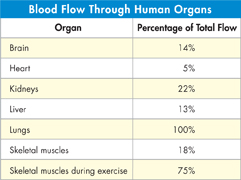33.3 The Respiratory System
Understand Key Concepts
The tiny hollow air sacs in the lungs where gas exchange takes place are the
alveoli.
lymph nodes.
capillaries.
bronchioles.
Two highly elastic folds of tissue known as the vocal cords are found in the
larynx.
pharynx.
trachea.
bronchi.
The large flat muscle that moves up and down and alters the volume of the chest cavity is the
trachea.
epiglottis.
diaphragm.
larynx.
What part of the brain controls involuntary breathing?
What are three dangerous substances in tobacco smoke? Describe how each affects the body.
How does emphysema affect the respiratory system?
Think Critically
Infer Tobacco smoke can kill white blood cells in the respiratory tract, the cells that help keep the respiratory system clean by consuming debris. How do you think this contributes to the development of smoker's cough?
Analyze Data The table shows the relative blood flow through some organs in the human body—that is, the percentage of blood that flows through a given organ. Through which organ(s) does all of the blood flow? Explain the effect of exercise on blood flow to skeletal muscles.
solve the CHAPTER MYSTERY

IN THE BLOOD
Both John and Lila have a genetic disease called familial hyper-cholesterolemia, which is caused by a gene defect on chromosome 19. John is heterozygous for the disorder. Although his liver cells make a mixture of normal and defective LDL receptors, his blood cholesterol levels were so high that he had serious atherosclerosis by age 35. Most people with this disease have had a heart attack by age 60.
Lila is homozygous for the defective allele—a very rare condition. Her liver cells do not produce any functional LDL receptors. Her atherosclerosis became apparent when she was only 4 years old. Fatty deposits can be seen in the corneas of her eyes and beneath the skin near her elbows and knees.
Research on this genetic defect helped uncover the role of liver cell LDL receptors in regulating blood cholesterol. Researchers then applied that information to cases of high cholesterol among the general public. The result was the development of several new classes of drugs that are helping some people live longer.
Predict If Lila were to have a child, what is the likelihood that she would pass on the allele for familial hypercholesterolemia to her child? If John had a son, what is the likelihood that the son inherited the allele?
Infer Most heterozygous patients can keep their LDL levels under control with medication that prevents their liver from making cholesterol. But these medications generally do not lower the LDL levels of homozygous patients. Why do you think that is so?
Connect to the
 If an individual knows that hypercholesterolemia runs in his or her family, what steps can he or she take to live a long and healthy life?
If an individual knows that hypercholesterolemia runs in his or her family, what steps can he or she take to live a long and healthy life?

Table of Contents
- Formulas and Equations
- Applying Formulas and Equations
- Mean, Median, and Mode
- Estimation
- Using Measurements in Calculations
- Effects of Measurement Errors
- Accuracy
- Precision
- Comparing Accuracy and Precision
- Significant Figures
- Calculating With Significant Figures
- Scientific Notation
- Calculating With Scientific Notation
- Dimensional Analysis
- Applying Dimensional Analysis





